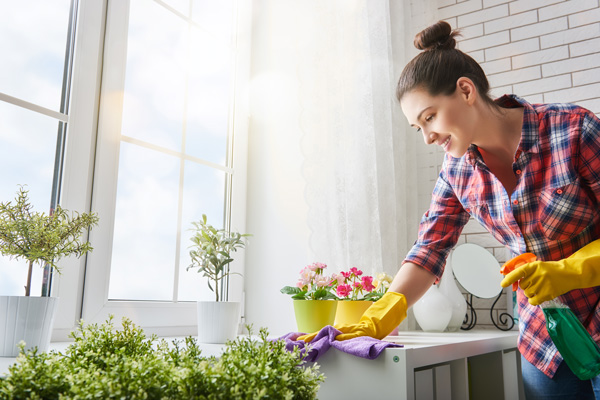Breathe Cleaner Air at Home
Posted on by WestAIR Heating & Cooling

In a previous blog, we discussed the importance of indoor air quality (IAQ), especially as it relates to your family’s comfort and health. With the cold winter temperatures keeping people inside, we wanted to revisit the topic and offer tips to breathe cleaner air at home.
Air Quality & Your Family’s Health
A lot of factors play a role in your overall health. One of the biggest is the air inside your home. This is particularly true right now, with more people spending time indoors to stay warm.
If your home has low-grade IAQ, you and your family may feel the effects. Poor air quality contributes to conditions including headaches, fatigue, skin irritation, coughs, and sore throats. Air pollutants can also trigger or worsen allergies and asthma.
Focus on Filters
Checking and changing air filters is a simple task you can perform to help ensure you and your family breathe cleaner air at home. Filters catch and remove contaminants as air passes through your HVAC system each time the unit runs.
Each month, check the filter to see whether it needs to be replaced. If you have animals, for instance, you may need to change the filter more often than in a pet-free home. Dirty filters can contribute to reduced air quality while putting undue stress on your heating and cooling unit.
Double-Check Ductwork
Your home’s ductwork is the system through which air passes from the HVAC unit to heat or cool each room, depending on the season. Dirty ducts can also distribute contaminants from one room to another as particles collect within the ductwork over time.
To ensure your ducts are free of debris and harmful pollutants, schedule regular duct cleaning maintenance from a professional and trusted team. Clean ducts will help keep the air within the home cleaner and safer for your family.
Manage Moisture
Moisture also contributes to the quality of your home’s indoor air. Help control that moisture with a whole-house humidifier.
Winter air is extremely dry and can cause sore throats or scratchy skin. A humidifier adds enough moisture to make your indoor air more comfortable to breathe. Adding a bit of moisture also helps the air stay warmer, allowing you to turn down your thermostat a few degrees in the winter.
Clear Out Contaminants
Another way to rid your home’s indoor air of harmful pollutants is with an air purifier. Working with your existing HVAC system and ductwork, an air purifier uses ultraviolet (UV) light technology to remove bacteria, viruses, mold, volatile organic compounds, and even odors.
The BreatheCLEAN UV purifiers from WestAIR Heating & Cooling offer an easy installation process and a number of health benefits, including:
- UV bulbs eliminate almost all harmful organisms
- Asthma and allergy relief
- Nonstop protection from viruses, mold, and bacteria
The knowledgeable and experienced professionals at WestAIR Heating & Cooling want to ensure your home safety and comfort. Contact us today to learn more about our indoor air quality products and services and how they can help you and your family breathe cleaner air at home.
This entry was posted in Duct Cleaning,Health Tips,Humidifier,Indoor Air Quality,Tips and tagged Air purifier, Clean air, Duct Cleaning and Indoor Air Quality, Humidifiers, IAQ, Indoor air quality
How to Improve Indoor Air Quality
Posted on by WestAIR Heating & Cooling
 In some cities, air pollution and smog create major health concerns. But the air inside of your home could contain more contaminates no matter where you live. Changing your living habits and investing in superior equipment will make major improvements to your indoor air quality.
In some cities, air pollution and smog create major health concerns. But the air inside of your home could contain more contaminates no matter where you live. Changing your living habits and investing in superior equipment will make major improvements to your indoor air quality.
Cleaning
If your home contains carpet, use a high-quality vacuum with a HEPA filter to reduce household dust, pet dander, and chemicals. Experts recommend vacuuming at least two times a week. For homes without carpet, sweeping and mopping effectively captures dirt and pollutants. Dry microfiber mops successfully grab dust and allergens as well but don’t require any chemical cleaners. Putting extra care into your cleaning routine will not only improve the look of your home but also the air quality. Think of all the chemicals, fecal matter, and allergens that cling to your shoes or clothing when you enter a building. Taking your shoes off or using a large matt to wipe your shoes can help reduce pollutants as well.
Reducing Toxicity
One of the worst culprits of compromised indoor air quality is cigarette smoke. The smoke contains more than 4,000 chemicals and can increase the risk of asthma, lung cancer, and stroke. Radon poses as another risk for lung cancer, especially in the Midwest where the gas concentrations are high. Radon gas comes from the natural decay of uranium in the ground and leaks through your home’s foundation. Call a professional if your house has not been tested for radon. Toxic particles can come from the products you use to clean, too. Fragrance and household chemicals emit VOCs (Volatile Organic Compounds). You can find VOCs in higher concentrations indoors, and they come with serious health risks. Reduce these chemicals by switching to natural or mild soaps or cleaners. Essential oils, vinegar, and baking soda can become effective DYI cleaners, too.
Air Support
Adding plants like dracaena, peace lilies, and spider plants improve indoor air quality and attractiveness inside your home. Air purifiers or air cleaners are even more effective at creating fresh and clean air. An air cleaner can capture 98% of airborne particles circulating through your home. We recommend these heating and cooling add-ons for people with asthma, allergies, or chronic illnesses. Depending on the MERV or HEPA rating, filters capture dust, pollen, mold, pet dander, pollutants, viruses and bacteria in the air. Dust mites and mold also thrive in moisture, so investing in an air exchanger or dehumidifier to use in the summer months will help as well. If your house smells musty or already shows signs of mold, you should invest in a dehumidifier.
Would you like better indoor air quality?
Contact WestAIR Heating and Cooling for more information on dehumidifiers and air cleaners.
This entry was posted in Indoor Air Quality and tagged Air cleaner, Air purifier, Allergies, Asthma, Bacteria, Breathe better, Cancer, Chemicals, Cigarettes, Clean air, Cleaning, Dehumidifier, Dust, Fragrance, HEPA, Home purifier, MERV, Mold, Natural alternatives, Pet dangers, Plants, Radon, Smoking, Toxic, Vacuum, Viruses, VOCs
Subscribe to Our Blog
With RSS feeds, you don't have to visit our site everyday to keep up to date. Simply subscribe to our blog via RSS or Email and our posts will come to you!
Search Blog Posts
Categories
Archives
- April 2024 (1)
- February 2024 (1)
- January 2024 (1)
- February 2023 (1)
- January 2023 (1)
- December 2022 (1)
- November 2022 (1)
- October 2022 (1)
- September 2022 (1)
- August 2022 (1)
- July 2022 (1)
- June 2022 (1)
- May 2022 (1)
- April 2022 (1)
- March 2022 (1)
- February 2022 (2)
- December 2021 (1)
- November 2021 (1)
- October 2021 (1)
- September 2021 (1)
- August 2021 (1)
- July 2021 (1)
- June 2021 (1)
- May 2021 (1)
- April 2021 (1)
- March 2021 (2)
- January 2021 (1)
- December 2020 (1)
- November 2020 (1)
- October 2020 (1)
- September 2020 (1)
- August 2020 (1)
- July 2020 (1)
- June 2020 (1)
- May 2020 (1)
- April 2020 (1)
- March 2020 (1)
- February 2020 (2)
- November 2019 (1)
- August 2019 (2)
- June 2019 (1)
- May 2019 (1)
- April 2019 (1)
- March 2019 (1)
- February 2019 (1)
- January 2019 (1)
- December 2018 (1)
- November 2018 (1)
- October 2018 (1)
- September 2018 (1)
- August 2018 (2)
- July 2018 (1)
- May 2018 (1)
- April 2018 (1)
- March 2018 (1)
- February 2018 (1)
- January 2018 (1)
- December 2017 (3)
- November 2017 (2)
- October 2017 (2)
- September 2017 (2)
- August 2017 (1)
- July 2017 (2)
- June 2017 (3)
- May 2017 (2)
- January 2017 (4)
- November 2016 (1)
- September 2016 (3)
- July 2016 (2)
- June 2016 (2)
- May 2016 (4)
- April 2016 (1)
- March 2016 (2)
- February 2016 (2)
- January 2016 (1)
- August 2015 (1)
- July 2015 (1)
- June 2015 (3)
- May 2015 (1)
- July 2014 (2)
- June 2014 (1)
- April 2014 (1)
- March 2014 (1)
- February 2014 (2)
- October 2013 (1)
- May 2013 (1)
- March 2013 (1)
- February 2013 (1)
- August 2012 (1)
- July 2012 (2)
- June 2012 (2)
- May 2012 (2)
- March 2012 (1)
- February 2012 (1)
- December 2011 (1)
- November 2011 (1)
- October 2011 (1)
- September 2011 (1)
- August 2011 (1)
- June 2011 (1)
- May 2011 (1)
 Subscribe
Subscribe Subscribe
Subscribe